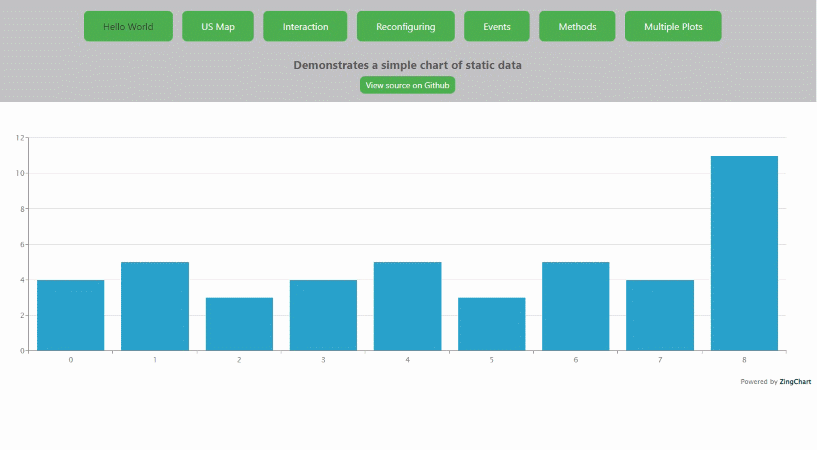zingchart-react
v3.2.0
Published
ZingChart React Component wrapper to allow native react syntax for javascript charts, chart events, chart methods and chart styling.
Downloads
3,814
Maintainers
Readme



Quickstart Guide
Quickly add charts to your React application with our ZingChart component
This guide assumes some basic working knowledge of React and jsx.
1. Install
Install the zingchart package via npm
npm install zingchart
Install the zingchart-react package via npm
npm install zingchart-react
2. Include the zingchart package in your project
The zingchart package is a DIRECT dependency of zingchart-react but you can also update this package outside of this component. Meaning the wrapper is no longer tied to a ZingChart library version, but just the component itself.
You can import the library like so:
// import the es6 version
import 'zingchart/es6';3. Include the component in your project
You can either include the zingchart-react component to your project via UMD or modules (recommended).
Modules (recommended)
import 'zingchart/es6';
import ZingChart from 'zingchart-react';You must EXPLICITLY IMPORT MODULE CHARTS. The modules are wrapped as a closure an eval statement so there is NO default export objects. Just import them.
import 'zingchart/es6';
import ZingChart from 'zingchart-react';
// EXPLICITLY IMPORT MODULE from node_modules
import "zingchart/modules-es6/zingchart-maps.min.js";
import "zingchart/modules-es6/zingchart-maps-usa.min.js";UMD
In your main html file, include the package as a script include.
<script src="/path/to/zingchart.min.js"></script>
<script src="/path/to/zingchart-react.js"></script>zingchart Global Object
If you need access to the window.zingchart objects for licensing or development flags or any top level
variables for other modules like zingchart.loadGeoJSON(). This is all exposed by importing the library as
the zingchart variable with import zingchart from 'zingchart/es6'.
import zingchart from 'zingchart/es6';
import ZingChart from 'zingchart-react';
// zingchart object for performance flags
zingchart.DEV.KEEPSOURCE = 0; // prevents lib from storing the original data package
zingchart.DEV.COPYDATA = 0; // prevents lib from creating a copy of the data package
// ZC object for license key
zingchart.LICENSE = ['abcdefghijklmnopqrstuvwxy'];Usage
Use the newly imported ZingChart component in your markup.
Using class components:
import React, {Component} from 'react';
import zingchart from 'zingchart/es6';
import ZingChart from 'zingchart-react';
/* Additional imports and settings as needed, see above */
class Simple extends Component {
constructor(props) {
super(props);
this.state = {
config: {
type: 'bar',
series: [{
values: [4,5,3,4,5,3,5,4,11]
}]
}
}
}
render() {
return (
<div >
<ZingChart data={this.state.config}/>
</div>
);
}
}
export default Simple;Using function components:
import React, {useState} from 'react';
import 'zingchart/es6';
import ZingChart from 'zingchart-react';
/* Additional imports and settings as needed, see above */
function Simple() {
const [config] = useState({
type: 'bar',
series: [{
values: [4,5,3,4,5,3,5,4,11]
}]
})
return <ZingChart data={config} />
}
export default Simple;Parameters
The properties, or parameters, you can pass to the <zingchart> tag itself.
data [object]
const myData = {
type: 'line',
series: [
{ values: [1,2,4,5,6] }
]
};
<zingchart data={myData}></zingchart>id [string] (optional)
The id for the DOM element for ZingChart to attach to. If no id is specified, the id will be autogenerated in the form of zingchart-react-#
series [array] (optional)
Accepts an array of series objects, and overrides a series if it was supplied into the config object. Varries by chart type used - Refer to the ZingChart documentation for more details.
const myData = {
type: 'line',
};
const mySeries = [
{ values: [1,2,4,5,6] }
];
<zingchart data={myData} series={mySeries}></zingchart>
width [string or number] (optional)
The width of the chart. Defaults to 100%.
height [string or number] (optional)
The height of the chart. Defaults to 480px.
theme [object] (optional)
The theme or 'defaults' object defined by ZingChart. More information available here: https://www.zingchart.com/docs/api/themes
modules [string] (optional)
The modules object to load additional modules. More information available here: https://www.zingchart.com/docs/api/zingchart-modules#modules-list
output [string] (optional)
The render type of the chart. The default is svg but you can also pass the string canvas to render the charts in canvas.
Note: All other properties that are added as a prop will be added to the render object. This allows for settings such as 'customprogresslogo' to be set. Any unrecognized properties will be ignored.
Events
All zingchart events are readily available on the component to listen to. For example, to listen for the 'complete' event when the chart is finished rendering:
class App extends Component {
constructor(props) {
super(props);
this.state = {
config: {
type: 'line',
series: [{
values: [4,5,3,4,5,3,5,4,11]
}]
}
}
this.chartDone = this.chartDone.bind(this);
}
render() {
return (
<div>
<ZingChart data={this.state.config} complete={this.chartDone}/>
</div>
);
}
chartDone(event) {
console.log(`Event "Complete" - The chart is rendered\n`);
}
}For a list of all the events that you can listen to, refer to the complete documentation on https://www.zingchart.com/docs/api/events
Methods
All zingchart methods are readily available on the component's instance to call. For example, to add a new plot node to the chart:
class App extends Component {
constructor(props) {
super(props);
this.state = {
config: {
type: 'bar',
series: [{
values: [4,5,3,4,5,3,5,4,11]
}]
}
};
this.chart = React.createRef();
this.addPlot = this.addPlot.bind(this);
}
render() {
return (
<div>
<ZingChart ref={this.chart} data={this.state.config}/>
<button onClick={this.addPlot}>AddPlot</button>
</div>
);
}
addPlot() {
this.chart.current.addplot({
data: {
values: [5,3,3,5,6,4,3,4,6],
text: "My new plot"
}
});
}
}
For a list of all the methods that you can call and the parameters each method can take, refer to the complete documentation on https://www.zingchart.com/docs/api/methods
Working Example
See https://github.com/zingchart-demos/zingchart-react-demo for a demo based on "Create React App" that shows this component in action.




